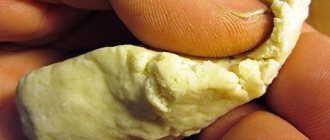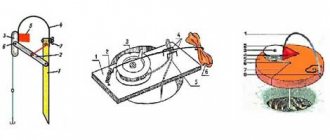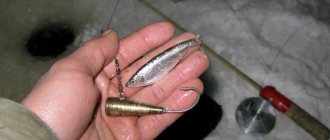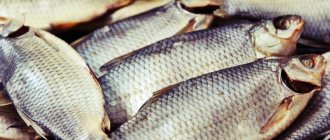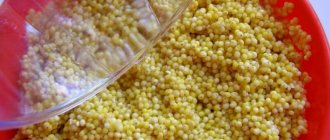Yuri 09/15/2020 727
Live bait is a live fish of various breeds, placed on a hook as bait for catching predatory fish. Experienced fishermen have been preparing bait since the fall, if they know how to store it correctly. It is quite difficult to provide a fish with vital functions before going fishing while living in an apartment. However, even in this situation there are some tricks. I’ll tell you how to keep live bait in a vigorous state for as long as possible.
The best bait for fish is its natural diet in a particular body of water.
You can buy live bait in the store, but the assortment usually only includes crucian carp, which are definitely not among the top preferences of predators. Where preferable are perch, brushfish or cod – you won’t find them on sale.
What kind of live bait is advisable to store?
As you know, a predator prefers to consume food that is familiar to it, so it is advisable to use small fish as live bait, which forms the basis of its food supply in a particular body of water. However, it is sometimes difficult to obtain it, especially in winter conditions.
This bait provides a rich catch even with a bad bite! More details In specialized stores you can get hold of any bait all year round, but they sell mainly juvenile crucian carp, which is clearly not among the top preferences of predators. Young perch and roach are the most in demand in winter, and burbots give preference to the favorite food of freshwater cod, brushes. They are rarely on sale, so you will most likely have to mine them yourself.
The obvious advantage of crucian carp is their record viability: at low temperatures they are able to go into suspended animation and remain alive for several days, even without water, in a basin on the balcony. But with representatives of other species you will have to tinker - they tolerate extraction from their native environment and storage in artificial conditions less well. Chickweed, bleak, and loaches are very popular with predators, but they tolerate changes in conditions extremely poorly, and therefore are not suitable for storage.
Techniques for catching live bait in winter
Fishing for live bait is extremely reminiscent of so-called sports fishing: lightweight tackle, a nod that is sensitive to bites, thin fishing line, and a jig with low weight and size. All this desire for lightness and minimization is a direct consequence of the fact that this gear is designed for catching small fish.
Like any winter fishing, fishing for live bait is preceded by drilling a hole. The place for it is chosen where small fish are most likely to be found, i.e. this is a deliberately shallow place, up to three meters, with very weak currents or in standing water.
Live bait is caught using bait consisting of bloodworms, burdock larvae, worms, and jigs attached to a hook (their biting activity is affected by their color). It is best to take jigs that have one side black and the other light. This combination of colors attracts both small roach and perch well. The bait fishing rod is balanced under the angler's hand.
Winter ways
In winter, long-term storage of live bait is much easier to organize. The answer to this phenomenon lies in the fact that at temperatures close to 0°C, the life processes of any representative of the ichthyofauna slow down, and the need for active movement and food disappears.
In this case, the main task of the fisherman is to maintain optimal temperature conditions in order to protect live bait from thermal shock. Even minor temperature fluctuations can destroy potential bait, making it unsuitable for further use.
Short term option
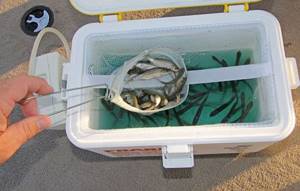
If you do not have the task of keeping the fish alive for a couple of weeks or more (you will go fishing within the next week), you don’t have to think too much. Immediately after purchase or capture, you can place it in a can of cold water, put it in a cool place (on the balcony, in the cellar, in the refrigerator) and take it out for fishing in the same form.
Kan is a special container for storing live bait. Once upon a time, fishermen made canals on their own or used buckets, tanks, cans for these purposes - in short, any containers into which water could be poured. You can resort to this method today, but for those who are seriously interested in live bait fishing, it is better to get a special cane.
Specialized stores sell all kinds of kana models. It is best to opt for a solid version made of EVA plastic. Such models have good thermal protection, which ensures the safety of the bait from freezing and pronounced temperature fluctuations. Naturally, a kana cannot be treated as an ideal thermos: the water in it heats up and cools down, just not as quickly as in a “protectless” container.
Another advantage of a good factory can is the presence of an internal plastic mesh container. You don’t have to reach into the water with your hands to remove the bait; just lift the mesh and the water will flow into the main container. Dry hands in the cold - this is important, you know!
In natural conditions
If you go to a specific body of water more or less regularly in winter, you can store live bait right there, in the hole. The sight of a fish frolicking in the visibility zone additionally attracts a predator to the fishing area, so placing the girders a few meters from the “storage” usually gives excellent results. The main thing is not to make too much noise when removing the device.
For this storage, you can use both homemade and purchased devices:
- Zadok . In this case, a cage made exclusively of metal mesh is used, which retains its shape. The main requirement is that it fits into the hole. Some fans of winter fishing make pipes up to two meters long from metal mesh, the diameter of the hole. In them, live bait feels quite at ease and natural waste is minimal.
- Bottle . Crucian carp and roach in the amount of a couple of dozen individuals feel great in a five-liter cylinder. You need to make a lot of holes in a plastic bottle (you can use a hot nail of a large diameter), place the bottle in the hole up to the neck, put a fish in there, screw on the lid.
- Plastic bag . If the conditions or characteristics of the ice drill do not allow drilling a hole of large diameter, you can get by with a thick-walled plastic bag of large volume (not for food, but for industrial purposes). It also needs to be perforated with a sleeve as often as possible (it is not necessary to heat it up, you can just tap it with a hammer). In this case, a balanced load is needed that does not stretch the bag downwards, but easily sends it to the bottom. And then it’s a matter of technique: we immerse the lower part of the bag in water, straighten the edges on the ice around the hole, pour water with live bait into it, and tie the bag.
All of the above-mentioned devices sink to the bottom. They are pre-equipped with ropes, to which crossbars are tied and laid across the holes. When the hole freezes over, you can disguise the location of the bait, the main thing is to detect the location of the storage yourself in order to find it the next time you go. In this way, you can ensure the safety of live bait throughout the winter period - the main thing is to periodically remove dead fish.
Long-term life support
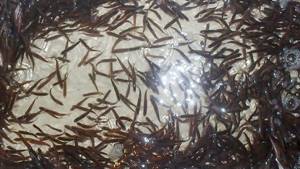
Subject to certain conditions and constant care, it is possible to maintain the life of bait fish for several months, even at home.
- Capacity _ Let’s make a reservation right away: the container should be as large as possible, where it is possible to ensure a live bait/water ratio of approximately 1/100. In this case, the ratio of height and diameter should be at least 1:2 (the lower and more spacious the surface of the container, the better natural aeration will be ensured). You can use a plastic or enamel basin or trough for these purposes, and ideally a children's inflatable pool, if you can place it in the proper conditions. Several dozen fish can be stored in a bucket or the same can, you just need to provide the proper conditions and care.
- Temperature regime . The optimal storage temperature is 1-2°C, and 3-5°C is already the upper limit. Water freezing should also not be allowed. This means that in warm winters you can keep the fish on the balcony or in an unheated corridor. The ideal storage location is an ice cellar: there the water is guaranteed not to get too hot and not freeze. When the temperature rises, you can throw a piece of ice into the water (only regular ice, from settled water!). To control, it is advisable to lower a household thermometer into the water.
- Water . It is advisable to use filtered or settled water for at least three days. When transplanting, you need to protect the live bait from thermal injury, that is, ensure a minimum temperature difference between the water in the original container and the container for long-term “residence.” During long-term storage, the water must be changed, otherwise the bait fish will die within a couple of weeks. However, this must be done in portions and constantly. The first partial replacement is usually done after 2-3 days, then about a quarter of the volume is taken daily and the same amount of fresh, settled water is added. The lower the population density of the container, the less often the water needs to be replaced.
- Aeration . One of the most important conditions for ensuring the life of a fish is maintaining a certain level of oxygen in the water. Elementary aeration is carried out in this way: every day we scoop up a certain volume of water with a mug a couple of dozen times and pour it back into the container from a height (along the way the water is saturated with oxygen). You can also use a regular bicycle pump, a rubber “frog” or a garden sprayer for these purposes (we just pump air into the water). An ordinary balloon also works well (inflate and release air into the water). The ball can be connected to a dropper: this will make it possible to supply air gradually, regulating its flow with the wheel of the drip system. The best option would be an aquarium aerator operating in constant mode (in this case, such frequent changes of water are not required, and in general there is an order of magnitude less hassle).
Historical information
Few people know that such a fish as the spined loach lives in rivers. She leads such a lifestyle that it is difficult to catch her, especially with a fishing rod.
At the slightest danger, she buries herself almost completely in the sand, leaving only part of her head with eyes outside in order to see everything that is happening around her. At the same time, spined lance can serve as an excellent live bait, since it can stay on the hook for a long time, remaining active.
Previously, she was caught in an unusual way. To do this, they entered the water up to their waists and began to move with the flow.
And here's what you need to know: Choosing an echo sounder for fishing from a boat: rating of good models
At the same time, when you pressed the bottom, you could determine that something was moving under your foot. The following actions boiled down to the fact that after a sharp squat, the sand was scooped up with the palms of the hands and quickly washed ashore; as a rule, this very pinched fish was found in the sand.
This fish is a desirable food source for many predatory fish.
Summer ways to store live bait
In the summer, it is much more difficult to ensure the life of a fish, and the larger it is, the faster it falls asleep. There are several reasons for this:
- Fish are much more active and require more space for comfort.
- Warm water quickly uses up oxygen reserves, becoming oversaturated with carbon dioxide.
- Any debris (especially organic matter) that gets into the container decomposes faster, poisoning the water.
However, it is much easier to get live bait in the summer. Therefore, even if they buy live bait, it is in small quantities, for one fishing trip. Store it in jars or cans in the refrigerator - it will last a couple of days. However, if there is a need for longer storage, for several weeks, you will have to tinker with creating optimal conditions.
If you do not have a cellar, it is unlikely that you will be able to keep even crucian carp alive for a long time. The task is complex - to create conditions close to those listed in the previous paragraph. The water will have to be changed daily, and it will be problematic to do without an aquarium aerator, and still it will not be possible to do without significant losses. In a word, it’s not worth the candle - it’s better to get fresh live bait before each fishing trip.
The only effective storage method in the summer is to place the fish in conditions close to natural. That is, a fish tank or a plastic bottle (the fish tank must be hard, otherwise there is a possibility that a predator will “chew” it) must be immersed in a body of water to a depth of several meters, where the water is cooler. It is recommended not to overpopulate the device - the greater the concentration of live bait, the greater the natural decline.
In any case, do not forget to remove dead baitfish: one fish that has begun to decompose will instantly destroy the entire bait.
Tips from experienced anglers
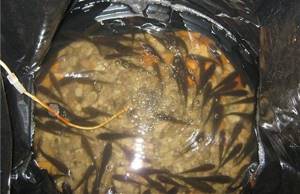
At the end of the publication, let me share a few practical tips from experienced fishermen:
- Separate live bait by species. It is better not to keep representatives of different species together, at least for more than a few days at home. The ruffe is especially destructive for its “neighbors” - it secretes caustic mucus (even under natural conditions it is better to move it into a separate cage).
- Do not overcrowd the container. Even for short-term storage, the live bait/water ratio should be at least 1/8. Crucian carp can be stocked more densely, and roach, perch, and ruff can be stocked more freely.
- Conduct your first experiments on crucian carp. As mentioned above, the most tenacious and unpretentious is crucian carp. It is enough to change the water in the container with it once every 10 days; it tolerates crowding and temperature fluctuations well. If you want to fuss less and do not have the relevant experience, stop at the little crucian carp.
- Do not handle live bait with your hands. Our hands are much warmer than the environment, and even more so the water that contains bait fish. In this case, picking up the fish with your hands is guaranteed to give it a temperature shock. You should get a special scoop with holes or a net specifically for placing live bait in the canal before fishing. You need to pour water from the main container into the can, carefully, without touching with your hands, transplant the live bait, and add water to the main container to the original level.
- Don't forget about feeding. Once a week or two the fish need to be fed. Dry food for aquarium fish or bloodworms are suitable for this purpose. Just don’t overdo it—sprinkle just a little, otherwise the decomposing food will poison the water.
We hope that our recommendations will help you preserve your bait for as long as possible, which will minimize the loss of time while fishing.
Fishermen wonder why I’m biting and they’re not?
I’m revealing a secret just for you: it’s all about the miracle bait! More details
Storage at home
Winter is the easiest time to preserve bait. Since the fish becomes sluggish from the cold and all its life processes slow down, there is no need for frequent feeding. And the liquid remains clean for a long time. Let's look at what methods exist for storing live bait at home.
On the balcony in an ordinary basin
You will need a regular basin. Place it with its contents on the balcony, where the ambient temperature should be above 0 degrees. There is no need to cover the container. Be sure to change the water every 2-3 days. Feed live bait with special dry mixtures or bloodworms, but in moderation. If it gets too cold on the balcony, take the basin home.
Take advantage of the basement
Bury a bottle or other container with live bait in the ground to a depth of 30-35 cm. Enrich the storage with oxygen by regularly changing the water. An alternative is an aquarium aerator. Feed the bait no more than once a day.
